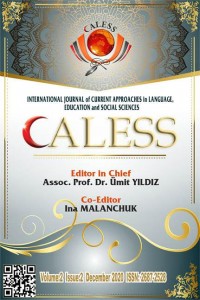Abstract
Although there are various studies on the tense phenomenon in the literature, the tense phenomenon addressed in these studies is absolute tense. In addition to this, there is no extensive research in the literature on the relative tense phenomenon although there are arguments stating that -mIştI and -DIydI forms express anterior tense in Turkish. In this study, we examined -mIştI and -DIydI forms, which are stated to express anterior tense in the sentences containing the form in the adverbial function, which is formed by the nominalizer -DIK, possessive and locative markers, by assuming that there is a relation between adverb(ial)s as functional heads and the categories of tense, aspect and modality. As a result of the data we analyzed, we found out that -mIştI and -DIydI forms express not only anterior tense but also posterior tense in certain grammatical and semantic conditions. We also studied the determining conditions.
Keywords
References
- Aydemir, İ. A. (2019). Türkçede zaman ve görünüş sistemi. Ankara: Nobel Akademik Yayıncılık.
- Cinque, G. (1999). Adverbs and functional heads: A cross-linguistic perspective. New York: Oxford University Press.
- Comrie, B. (1976). Aspect. Cambridge: Cambridge University Press.
- Comrie, B. (1985). Tense. Cambridge: Cambridge University Press.
- Dahl, Ö. (1985). Tense and aspect systems. Oxford: Blackwell.
- Filip, H. (2012). Lexical aspect. R. I. Binnick (Ed.) içinde, The Oxford handbook of tense and aspect (ss. 721-751). New York: Oxford University Press.
- Göksel, A. ve Kerslake, C. (2005). Turkish: A comprehensive grammar. London: Routledge.
- Haiman, J. (1980). Hua: a Papuan language of the eastern highlands of New Guinea. Amsterdam: John Benjamins.
- Hengeveld, K. (1998). Adverbial clauses in the languages of Europe. J. Van der Auwera (Ed.) içinde, Adverbial Construction in the Languages of Europe (ss. 25-145). Berlin: Mouton de Gruyter.
- İşsever, S. (2000). Türkçede bilgi yapısı (Yayınlanmamış doktora tezi). Ankara Üniversitesi, Ankara.
- Johanson, L. (2016). Türkçede görünüş. (N. Demir, Çev.). Ankara: Grafiker Yayınları. (Orijinal eserin yayın tarihi, 1971).
- Kornfilt, J. (1997). Turkish. London, New York: Routledge.
- Mufwene, S. S. (1990). Time reference in Kikongo-Kituba. J. V. Singler (Ed.) içinde, Pidgin and Creole Tense-Mood-Aspect (ss. 97-118). Amsterdam: John Benjamins.
- Rizzi, L. (1997). The fine structure of the left periphery. Haegeman L. (Ed.) içinde, Elements of Grammar (ss. 281-337). Dordrecht: Springer.
- Rizzi, L. ve Cinque, G. (2016). Functional categories and syntactic theory. Annual Review of Linguistics, (2), 139–163.
- Sezer, E. (2001). Finite inflection in Turkish. E. Erguvanlı-Taylan (Ed.) içinde, The Verb in Turkish (ss. 1-45). Amsterdam: John Benjamins.
- Underhill, R. (1976). Turkish grammar. Cambridge: MIT Press.
- Uzun, N. E. (1998). Türkçe'de görünüş/kip/zaman üçlüsü. Dil Dergisi, (68), 5-22.
- van Schaaik, G. (2001). Periphrastic tense/aspect/mood. E. Erguvanlı-Taylan (Ed.) içinde, The Verb in Turkish (ss. 61-95). Amsterdam: John Benjamins.
- Yangın, M. T. (2020). Türkçede belirteçlerin yansıttığı işlevsel başlar ve kip-görünüş-zaman ilişkisi (Yayınlanmamış yüksek lisans tezi). Dokuz Eylül Üniversitesi, İzmir.
Abstract
Alanyazında zaman olgusuna ilişkin çeşitli çalışmalar yer almasına karşın söz konusu çalışmalarda ele alınan zaman olgusu mutlak zamandır. Bunun yanı sıra, Türkçede -mIştI ve -DIydI yapılanmalarının öncelik göreceli zaman ifade ettiğine ilişkin görüşler yer alsa da göreceli zaman olgusuna ilişkin alanyazında kapsamlı bir çalışma yer almamaktadır. Bu çalışmada ise işlevsel baş olarak belirteçlerin kip, görünüş ve zaman ulamlarıyla arasındaki ilişkinin var olduğunu sayıltılayarak; -DIK adlaştırma biçimi ile iyelik ve bulunma durum belirticileriyle oluşan belirtecimsi işlevindeki biçimin bulunduğu tümcelerde öncelik göreceli zamanını ifade ettiği belirtilen -mIştI ve -DIydI yapılarını inceledik. İncelediğimiz veriler sonucunda, -mIştI ve -DIydI yapılarının yalnızca öncelik göreceli zamanını değil, belirli dilbilgisel ve anlamsal koşullarda sonralık da ifade ettiğini saptadık. Bununla birlikte, bu koşulların neler olduğunu belirledik.
References
- Aydemir, İ. A. (2019). Türkçede zaman ve görünüş sistemi. Ankara: Nobel Akademik Yayıncılık.
- Cinque, G. (1999). Adverbs and functional heads: A cross-linguistic perspective. New York: Oxford University Press.
- Comrie, B. (1976). Aspect. Cambridge: Cambridge University Press.
- Comrie, B. (1985). Tense. Cambridge: Cambridge University Press.
- Dahl, Ö. (1985). Tense and aspect systems. Oxford: Blackwell.
- Filip, H. (2012). Lexical aspect. R. I. Binnick (Ed.) içinde, The Oxford handbook of tense and aspect (ss. 721-751). New York: Oxford University Press.
- Göksel, A. ve Kerslake, C. (2005). Turkish: A comprehensive grammar. London: Routledge.
- Haiman, J. (1980). Hua: a Papuan language of the eastern highlands of New Guinea. Amsterdam: John Benjamins.
- Hengeveld, K. (1998). Adverbial clauses in the languages of Europe. J. Van der Auwera (Ed.) içinde, Adverbial Construction in the Languages of Europe (ss. 25-145). Berlin: Mouton de Gruyter.
- İşsever, S. (2000). Türkçede bilgi yapısı (Yayınlanmamış doktora tezi). Ankara Üniversitesi, Ankara.
- Johanson, L. (2016). Türkçede görünüş. (N. Demir, Çev.). Ankara: Grafiker Yayınları. (Orijinal eserin yayın tarihi, 1971).
- Kornfilt, J. (1997). Turkish. London, New York: Routledge.
- Mufwene, S. S. (1990). Time reference in Kikongo-Kituba. J. V. Singler (Ed.) içinde, Pidgin and Creole Tense-Mood-Aspect (ss. 97-118). Amsterdam: John Benjamins.
- Rizzi, L. (1997). The fine structure of the left periphery. Haegeman L. (Ed.) içinde, Elements of Grammar (ss. 281-337). Dordrecht: Springer.
- Rizzi, L. ve Cinque, G. (2016). Functional categories and syntactic theory. Annual Review of Linguistics, (2), 139–163.
- Sezer, E. (2001). Finite inflection in Turkish. E. Erguvanlı-Taylan (Ed.) içinde, The Verb in Turkish (ss. 1-45). Amsterdam: John Benjamins.
- Underhill, R. (1976). Turkish grammar. Cambridge: MIT Press.
- Uzun, N. E. (1998). Türkçe'de görünüş/kip/zaman üçlüsü. Dil Dergisi, (68), 5-22.
- van Schaaik, G. (2001). Periphrastic tense/aspect/mood. E. Erguvanlı-Taylan (Ed.) içinde, The Verb in Turkish (ss. 61-95). Amsterdam: John Benjamins.
- Yangın, M. T. (2020). Türkçede belirteçlerin yansıttığı işlevsel başlar ve kip-görünüş-zaman ilişkisi (Yayınlanmamış yüksek lisans tezi). Dokuz Eylül Üniversitesi, İzmir.
Details
| Primary Language | Turkish |
|---|---|
| Journal Section | Research Articles |
| Authors | |
| Publication Date | December 27, 2020 |
| Published in Issue | Year 2020 Volume: 2 Issue: 2 |

